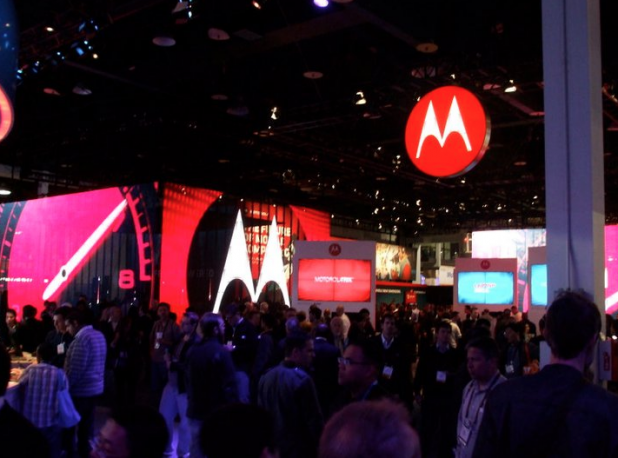 Chaos... reigns![/caption] Every January, thousands of developers and startup executives flood Vegas with dreams of a big score. But they’re not headed to the poker and blackjack tables in pursuit of that filthy lucre—instead, many of them have dropped thousands of dollars on a booth at the Consumer Electronics Show (CES), arguably the highest-profile technology conference of the year. (In addition to the tens of thousands of dollars it costs to reserve a space on the convention-hall floor, that money goes to demo units, flying employees to Vegas, and much, much more.) If they haven’t managed to secure a spot in one of the Convention Center’s massive halls, they’ve set up a demonstration area in a suite at some hotel on the Strip. And if they’re too under-capitalized or unprepared for a hotel, they’re lurking in the Convention Center parking lot. Seriously. It’s a little insane. If you’re a tech journalist covering CES, you have your encounters: that overzealous PR person who grabs your elbow in the taxi line and refuses to let go unless you submit to his 30-second pitch; the startup founder who leaps toward you at a party with the speed and intensity of an NFL linebacker one bad game away from being fired; the sales rep for New Company X who shoots you five (or ten) emails an hour despite your repeated entreaties to be left alone. It’s wonderful to be wanted, yes, but the desperation is off-putting, to put it mildly. In a certain way, you can’t blame the startups: at some point, someone told them that CES is the best way to get their company noticed, even if it means blowing the equivalent of three employees’ yearly salaries. On paper, the get-a-booth strategy makes sense—aside from SXSW, CES hosts possibly the greatest concentration of tech journalists in a relatively small space. What many first-timers don’t realize (until it’s too late) is that startups have a hard time standing out amidst the chaos: there are too many companies at too many booths attempting to sell (at top volume) too many variations of the same core ideas. If that wasn’t bad enough, a fair portion of those companies are trying to draw attention with flashing screens, giveaways, music pumping at top volume, and other gimmicks. (Hey, it’s Vegas.) So not only does your Nike FuelBand knockoff need to compete against a hundred other “smart bracelets” on display, but you somehow need to make yourself visible despite the plus-size Elvis impersonator belting out “Don’t Be Cruel” in front of that chip-vendor’s booth a few steps away. That’s just the sort of quixotic endeavor that would drive even the most stalwart startup founder to drinking before 9 A.M. Many startups come to CES betting that they’ll catch the eye of some enterprising tech reporter. But most journalists don’t have enough time for anything other than a couple of convention-floor walk-throughs; they’re on their way to keynotes and presentations given by the big manufacturers, or that giant mother-ship of a Samsung booth. For wet-behind-the-ears firms, it could pay increased dividends to skip CES and shovel that cash back into the business; companies with a fair amount of brand recognition—and enough cash to make themselves truly stand out in the arm’s race that’s the show-floor—tend to reap the biggest rewards from the conference. But that’s not advice that a lot of startups follow—which is why a lot of startups that make their “debut” at CES never survive to the end of the year.
Chaos... reigns![/caption] Every January, thousands of developers and startup executives flood Vegas with dreams of a big score. But they’re not headed to the poker and blackjack tables in pursuit of that filthy lucre—instead, many of them have dropped thousands of dollars on a booth at the Consumer Electronics Show (CES), arguably the highest-profile technology conference of the year. (In addition to the tens of thousands of dollars it costs to reserve a space on the convention-hall floor, that money goes to demo units, flying employees to Vegas, and much, much more.) If they haven’t managed to secure a spot in one of the Convention Center’s massive halls, they’ve set up a demonstration area in a suite at some hotel on the Strip. And if they’re too under-capitalized or unprepared for a hotel, they’re lurking in the Convention Center parking lot. Seriously. It’s a little insane. If you’re a tech journalist covering CES, you have your encounters: that overzealous PR person who grabs your elbow in the taxi line and refuses to let go unless you submit to his 30-second pitch; the startup founder who leaps toward you at a party with the speed and intensity of an NFL linebacker one bad game away from being fired; the sales rep for New Company X who shoots you five (or ten) emails an hour despite your repeated entreaties to be left alone. It’s wonderful to be wanted, yes, but the desperation is off-putting, to put it mildly. In a certain way, you can’t blame the startups: at some point, someone told them that CES is the best way to get their company noticed, even if it means blowing the equivalent of three employees’ yearly salaries. On paper, the get-a-booth strategy makes sense—aside from SXSW, CES hosts possibly the greatest concentration of tech journalists in a relatively small space. What many first-timers don’t realize (until it’s too late) is that startups have a hard time standing out amidst the chaos: there are too many companies at too many booths attempting to sell (at top volume) too many variations of the same core ideas. If that wasn’t bad enough, a fair portion of those companies are trying to draw attention with flashing screens, giveaways, music pumping at top volume, and other gimmicks. (Hey, it’s Vegas.) So not only does your Nike FuelBand knockoff need to compete against a hundred other “smart bracelets” on display, but you somehow need to make yourself visible despite the plus-size Elvis impersonator belting out “Don’t Be Cruel” in front of that chip-vendor’s booth a few steps away. That’s just the sort of quixotic endeavor that would drive even the most stalwart startup founder to drinking before 9 A.M. Many startups come to CES betting that they’ll catch the eye of some enterprising tech reporter. But most journalists don’t have enough time for anything other than a couple of convention-floor walk-throughs; they’re on their way to keynotes and presentations given by the big manufacturers, or that giant mother-ship of a Samsung booth. For wet-behind-the-ears firms, it could pay increased dividends to skip CES and shovel that cash back into the business; companies with a fair amount of brand recognition—and enough cash to make themselves truly stand out in the arm’s race that’s the show-floor—tend to reap the biggest rewards from the conference. But that’s not advice that a lot of startups follow—which is why a lot of startups that make their “debut” at CES never survive to the end of the year. Why CES Is a Bad Scene for Startups
[caption id="attachment_15811" align="aligncenter" width="618"]  Chaos... reigns![/caption] Every January, thousands of developers and startup executives flood Vegas with dreams of a big score. But they’re not headed to the poker and blackjack tables in pursuit of that filthy lucre—instead, many of them have dropped thousands of dollars on a booth at the Consumer Electronics Show (CES), arguably the highest-profile technology conference of the year. (In addition to the tens of thousands of dollars it costs to reserve a space on the convention-hall floor, that money goes to demo units, flying employees to Vegas, and much, much more.) If they haven’t managed to secure a spot in one of the Convention Center’s massive halls, they’ve set up a demonstration area in a suite at some hotel on the Strip. And if they’re too under-capitalized or unprepared for a hotel, they’re lurking in the Convention Center parking lot. Seriously. It’s a little insane. If you’re a tech journalist covering CES, you have your encounters: that overzealous PR person who grabs your elbow in the taxi line and refuses to let go unless you submit to his 30-second pitch; the startup founder who leaps toward you at a party with the speed and intensity of an NFL linebacker one bad game away from being fired; the sales rep for New Company X who shoots you five (or ten) emails an hour despite your repeated entreaties to be left alone. It’s wonderful to be wanted, yes, but the desperation is off-putting, to put it mildly. In a certain way, you can’t blame the startups: at some point, someone told them that CES is the best way to get their company noticed, even if it means blowing the equivalent of three employees’ yearly salaries. On paper, the get-a-booth strategy makes sense—aside from SXSW, CES hosts possibly the greatest concentration of tech journalists in a relatively small space. What many first-timers don’t realize (until it’s too late) is that startups have a hard time standing out amidst the chaos: there are too many companies at too many booths attempting to sell (at top volume) too many variations of the same core ideas. If that wasn’t bad enough, a fair portion of those companies are trying to draw attention with flashing screens, giveaways, music pumping at top volume, and other gimmicks. (Hey, it’s Vegas.) So not only does your Nike FuelBand knockoff need to compete against a hundred other “smart bracelets” on display, but you somehow need to make yourself visible despite the plus-size Elvis impersonator belting out “Don’t Be Cruel” in front of that chip-vendor’s booth a few steps away. That’s just the sort of quixotic endeavor that would drive even the most stalwart startup founder to drinking before 9 A.M. Many startups come to CES betting that they’ll catch the eye of some enterprising tech reporter. But most journalists don’t have enough time for anything other than a couple of convention-floor walk-throughs; they’re on their way to keynotes and presentations given by the big manufacturers, or that giant mother-ship of a Samsung booth. For wet-behind-the-ears firms, it could pay increased dividends to skip CES and shovel that cash back into the business; companies with a fair amount of brand recognition—and enough cash to make themselves truly stand out in the arm’s race that’s the show-floor—tend to reap the biggest rewards from the conference. But that’s not advice that a lot of startups follow—which is why a lot of startups that make their “debut” at CES never survive to the end of the year.
Chaos... reigns![/caption] Every January, thousands of developers and startup executives flood Vegas with dreams of a big score. But they’re not headed to the poker and blackjack tables in pursuit of that filthy lucre—instead, many of them have dropped thousands of dollars on a booth at the Consumer Electronics Show (CES), arguably the highest-profile technology conference of the year. (In addition to the tens of thousands of dollars it costs to reserve a space on the convention-hall floor, that money goes to demo units, flying employees to Vegas, and much, much more.) If they haven’t managed to secure a spot in one of the Convention Center’s massive halls, they’ve set up a demonstration area in a suite at some hotel on the Strip. And if they’re too under-capitalized or unprepared for a hotel, they’re lurking in the Convention Center parking lot. Seriously. It’s a little insane. If you’re a tech journalist covering CES, you have your encounters: that overzealous PR person who grabs your elbow in the taxi line and refuses to let go unless you submit to his 30-second pitch; the startup founder who leaps toward you at a party with the speed and intensity of an NFL linebacker one bad game away from being fired; the sales rep for New Company X who shoots you five (or ten) emails an hour despite your repeated entreaties to be left alone. It’s wonderful to be wanted, yes, but the desperation is off-putting, to put it mildly. In a certain way, you can’t blame the startups: at some point, someone told them that CES is the best way to get their company noticed, even if it means blowing the equivalent of three employees’ yearly salaries. On paper, the get-a-booth strategy makes sense—aside from SXSW, CES hosts possibly the greatest concentration of tech journalists in a relatively small space. What many first-timers don’t realize (until it’s too late) is that startups have a hard time standing out amidst the chaos: there are too many companies at too many booths attempting to sell (at top volume) too many variations of the same core ideas. If that wasn’t bad enough, a fair portion of those companies are trying to draw attention with flashing screens, giveaways, music pumping at top volume, and other gimmicks. (Hey, it’s Vegas.) So not only does your Nike FuelBand knockoff need to compete against a hundred other “smart bracelets” on display, but you somehow need to make yourself visible despite the plus-size Elvis impersonator belting out “Don’t Be Cruel” in front of that chip-vendor’s booth a few steps away. That’s just the sort of quixotic endeavor that would drive even the most stalwart startup founder to drinking before 9 A.M. Many startups come to CES betting that they’ll catch the eye of some enterprising tech reporter. But most journalists don’t have enough time for anything other than a couple of convention-floor walk-throughs; they’re on their way to keynotes and presentations given by the big manufacturers, or that giant mother-ship of a Samsung booth. For wet-behind-the-ears firms, it could pay increased dividends to skip CES and shovel that cash back into the business; companies with a fair amount of brand recognition—and enough cash to make themselves truly stand out in the arm’s race that’s the show-floor—tend to reap the biggest rewards from the conference. But that’s not advice that a lot of startups follow—which is why a lot of startups that make their “debut” at CES never survive to the end of the year.
 Chaos... reigns![/caption] Every January, thousands of developers and startup executives flood Vegas with dreams of a big score. But they’re not headed to the poker and blackjack tables in pursuit of that filthy lucre—instead, many of them have dropped thousands of dollars on a booth at the Consumer Electronics Show (CES), arguably the highest-profile technology conference of the year. (In addition to the tens of thousands of dollars it costs to reserve a space on the convention-hall floor, that money goes to demo units, flying employees to Vegas, and much, much more.) If they haven’t managed to secure a spot in one of the Convention Center’s massive halls, they’ve set up a demonstration area in a suite at some hotel on the Strip. And if they’re too under-capitalized or unprepared for a hotel, they’re lurking in the Convention Center parking lot. Seriously. It’s a little insane. If you’re a tech journalist covering CES, you have your encounters: that overzealous PR person who grabs your elbow in the taxi line and refuses to let go unless you submit to his 30-second pitch; the startup founder who leaps toward you at a party with the speed and intensity of an NFL linebacker one bad game away from being fired; the sales rep for New Company X who shoots you five (or ten) emails an hour despite your repeated entreaties to be left alone. It’s wonderful to be wanted, yes, but the desperation is off-putting, to put it mildly. In a certain way, you can’t blame the startups: at some point, someone told them that CES is the best way to get their company noticed, even if it means blowing the equivalent of three employees’ yearly salaries. On paper, the get-a-booth strategy makes sense—aside from SXSW, CES hosts possibly the greatest concentration of tech journalists in a relatively small space. What many first-timers don’t realize (until it’s too late) is that startups have a hard time standing out amidst the chaos: there are too many companies at too many booths attempting to sell (at top volume) too many variations of the same core ideas. If that wasn’t bad enough, a fair portion of those companies are trying to draw attention with flashing screens, giveaways, music pumping at top volume, and other gimmicks. (Hey, it’s Vegas.) So not only does your Nike FuelBand knockoff need to compete against a hundred other “smart bracelets” on display, but you somehow need to make yourself visible despite the plus-size Elvis impersonator belting out “Don’t Be Cruel” in front of that chip-vendor’s booth a few steps away. That’s just the sort of quixotic endeavor that would drive even the most stalwart startup founder to drinking before 9 A.M. Many startups come to CES betting that they’ll catch the eye of some enterprising tech reporter. But most journalists don’t have enough time for anything other than a couple of convention-floor walk-throughs; they’re on their way to keynotes and presentations given by the big manufacturers, or that giant mother-ship of a Samsung booth. For wet-behind-the-ears firms, it could pay increased dividends to skip CES and shovel that cash back into the business; companies with a fair amount of brand recognition—and enough cash to make themselves truly stand out in the arm’s race that’s the show-floor—tend to reap the biggest rewards from the conference. But that’s not advice that a lot of startups follow—which is why a lot of startups that make their “debut” at CES never survive to the end of the year.
Chaos... reigns![/caption] Every January, thousands of developers and startup executives flood Vegas with dreams of a big score. But they’re not headed to the poker and blackjack tables in pursuit of that filthy lucre—instead, many of them have dropped thousands of dollars on a booth at the Consumer Electronics Show (CES), arguably the highest-profile technology conference of the year. (In addition to the tens of thousands of dollars it costs to reserve a space on the convention-hall floor, that money goes to demo units, flying employees to Vegas, and much, much more.) If they haven’t managed to secure a spot in one of the Convention Center’s massive halls, they’ve set up a demonstration area in a suite at some hotel on the Strip. And if they’re too under-capitalized or unprepared for a hotel, they’re lurking in the Convention Center parking lot. Seriously. It’s a little insane. If you’re a tech journalist covering CES, you have your encounters: that overzealous PR person who grabs your elbow in the taxi line and refuses to let go unless you submit to his 30-second pitch; the startup founder who leaps toward you at a party with the speed and intensity of an NFL linebacker one bad game away from being fired; the sales rep for New Company X who shoots you five (or ten) emails an hour despite your repeated entreaties to be left alone. It’s wonderful to be wanted, yes, but the desperation is off-putting, to put it mildly. In a certain way, you can’t blame the startups: at some point, someone told them that CES is the best way to get their company noticed, even if it means blowing the equivalent of three employees’ yearly salaries. On paper, the get-a-booth strategy makes sense—aside from SXSW, CES hosts possibly the greatest concentration of tech journalists in a relatively small space. What many first-timers don’t realize (until it’s too late) is that startups have a hard time standing out amidst the chaos: there are too many companies at too many booths attempting to sell (at top volume) too many variations of the same core ideas. If that wasn’t bad enough, a fair portion of those companies are trying to draw attention with flashing screens, giveaways, music pumping at top volume, and other gimmicks. (Hey, it’s Vegas.) So not only does your Nike FuelBand knockoff need to compete against a hundred other “smart bracelets” on display, but you somehow need to make yourself visible despite the plus-size Elvis impersonator belting out “Don’t Be Cruel” in front of that chip-vendor’s booth a few steps away. That’s just the sort of quixotic endeavor that would drive even the most stalwart startup founder to drinking before 9 A.M. Many startups come to CES betting that they’ll catch the eye of some enterprising tech reporter. But most journalists don’t have enough time for anything other than a couple of convention-floor walk-throughs; they’re on their way to keynotes and presentations given by the big manufacturers, or that giant mother-ship of a Samsung booth. For wet-behind-the-ears firms, it could pay increased dividends to skip CES and shovel that cash back into the business; companies with a fair amount of brand recognition—and enough cash to make themselves truly stand out in the arm’s race that’s the show-floor—tend to reap the biggest rewards from the conference. But that’s not advice that a lot of startups follow—which is why a lot of startups that make their “debut” at CES never survive to the end of the year. 

